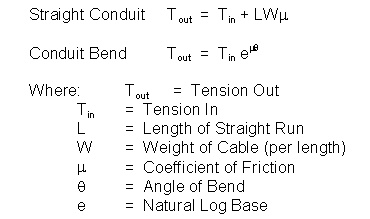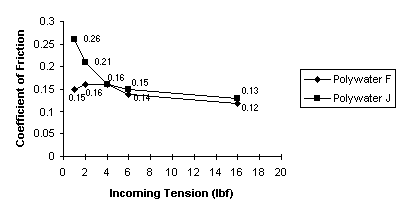| |
|||||||||
| |
|
|
|
|
|
|
|
||
| Home | About | Literature | Site Map | MSDS | Contact | Engineers | Shows | Links | Samples | RFQ | Catalog Numbers |

The Problem
When you calculate cable pulling tensions, what friction coefficient do you use? Field responses vary . . . some answer ".5" . . . others ".45," ".4," or ".35" . . . and, recently, a European engineer responded "usually .2 to .3." Who's right?? What coefficient of friction should you use in pulling equations to provide the best tension estimates for better field planning and electrical system design?
The Basics
To answer this question, we need to understand more about "coefficient of friction." What is it and where does it come from?
Let's use an old physics class example . . . a wooden block (say, 10 lbs. in weight) on a horizontal steel plate. Say it takes 5 lbs. force (lbf.) to pull (drag) the block across the plate. The coefficient of friction (wood block to steel plate) is defined as the ratio of the "dragging force" (5 lbf.) to the normal force (weight or 10 lbf.) or, in this case, the friction coefficient would be .5 (dimensionless number)
Experience tells us that if we replace the wooden block with a 10 lb. rubber block. it will take a greater force to drag the rubber block (say, 12 lbf.). The measured coefficient of friction (rubber/steel) would be 1.2. What's important to note in these examples is that the friction coefficient is specific to the rubbing surfaces.
Cable/Conduit
Replace the block with cable and the plate with conduit, and we have cable pulling . . . with a few complications. Neither the cable nor the conduit is flat. There may be more than one cable which can result in complex rubbing surfaces. Pulls are not straight, so forces other than gravitational weight occur at conduit bends. Finally, pulling compounds (lubricants) are used to change and presumably lower the friction coefficient.
Even with these differences in cable pulling, the friction coefficient continues to depend on the jacket type, conduit type, and, additionally, the lubricant type. "Generalized" coefficients of friction don't mean much. The best tension estimates come from friction coefficients specific to cable, conduit, and lubricant.
Pulling Equations
Most of the unique cable pulling characteristics mentioned previously are handled in the cable pulling equations. This includes the non-gravitational forces present at conduit bends.
Examining a simplified form of the equations will clarify:

Note how significant changes in "µ" (friction coefficient) can be, especially in conduit bends, where the friction variable is in the exponent. Inaccurate coefficients of friction lead to poor results in tension calculations. Unfortunately, it is in the multi-bend pulls, where the tension and sidewall pressure are of most concern, that the use of an inaccurate coefficient of friction produces the greatest error.
Where can you find or how can you determine meaningful friction coefficients?
EPRI Study Helpful
The Electric Power Research Institute study, "Maximum Safe Pulling Lengths for Solid Dielectric Insulated Cables," provides insight, and some surprises, on lubricated cable friction and its measurement.
The EPRI research showed that lubricated coefficient of friction changes with varying normal force (the force pushing the cable against the conduit wall). The EPRI report defines two coefficients of friction, one at "high sidewall bearing pressure" (High SBP) (going around bends) and the other at "low sidewall bearing pressure" (Low SBP) (straight pulls). Surprisingly, the High SBP friction coefficient is often lower than the Low SBP friction coefficient, often lower by a factor of more than 2.
The EPRI report goes on to recommend that the High SBP friction coefficient be used in calculations when normal force on the cable is over 150 lbs./ft. and that otherwise the Low SBP coefficient of friction be used.
Polywater Research Clarifying
American Polywater studies confirm the variance in friction coefficient with normal pressure. We have determined that the friction at low normal bearing force is a measure of hydrodynamic friction, which is roughly proportional to lubricant viscosity (internal gel strength of the lubricant).
In contrast to the EPRI work, however, our research indicates the conversion in friction to the High SBP type occurs continuously and at bearing pressures considerably less than 150 lbs./ft.
Show me!!
One test illustrating this "variable friction coefficient" involves pulling cable through multiple, consecutive 90° duct bends (helix, total degrees of bend, and incoming cable tension can all be varied. From the pulling force (measured with a load cell) required to move the cable, we can determine a coefficient of friction back calculating from the pulling equations.
The graph below shows such calculated friction coefficients plotted against the tension on the cable as it enters the conduit helix. For this graph, the conduit was HDPE with a total of 540 degrees of bend (1.25 radius each). The cable had a PE jacket.

To explain the graph, first you must know that Polywater® J and Polywater® F are two of American Polywater's high-performance cable pulling lubricants ("J" is usually used for electrical cable and "F" for fiber optic cable). They are similar chemically, except that "J" is a gel lubricant (higher viscosity) and "F" is a liquid.
Where the curves converge, and the slope levels, the low bearing pressure friction has disappeared and the cable lubricant are in a high bearing pressure mode. By calculating the sidewall-bearing pressures (defined as tension out of the bend divided by bend radius) at this point of convergence, we find that the change from Low SBP friction to High SBP friction is complete at 4 lbs./ft. bearing pressure.
Because power cable's stiffness and resulting "spring" tend to increase conduit contact pressure, power cable pulling ends up in the "high bearing pressure" mode most of the time. Field-measured tensions tend to support this conclusion.
On the other hand, lighter, flexible cables (control, instrumentation, fiber optic, etc.) may demonstrate both types of friction during pulling. (Installation note: A low viscosity, liquid lubricant like Polywater® F is best for these types of installations.)
Friction Fantasy
Unfortunately, a number of cable lubricant manufacturers (not American Polywater) publish "friction coefficient" data which ignore cable jacket, conduit, and bearing pressure considerations (not to mention ambient temperature, state of drying, and other critical factors). Such data is pure friction fantasy!!
Be sure you use friction coefficients determined by appropriate measurement methods, such as American Polywater's variable normal pressure friction table. Simple inclined plane or sled-type friction tests do not provide valid results for comparison or calculational purposes.
But It Worked in the Office!
For the same reasons, be wary of "office" demonstrations of "coefficient of friction." One manufacturer, which has "miniaturized rollers" in its lubricant, can put on a "neat" desktop demonstration with a small piece of cable and conduit (very Low SBP). Unfortunately, at field bearing pressures, the little rollers can dig in and score the cable jacket. They usually do much more damage than good.
Data at your Fingertips
American Polywater's laboratory has developed extensive friction data for different cable jacket and conduit types, at field-appropriate bearing pressures. This data is normally supplied with our Pull-Planner™ 3000 Software.
The Pull-Planner™ 3000 Program also provides a convenient way to estimate cable pulling tensions on a personal computer. Our Polywater® Lubricants provide low friction coefficients for minimum tension on critical cable installations.
To order the software for $129, contact American Polywater's Technical Service Department at 1-800-328-9384 (1-651-430-2270 OUS).
View this article in PDF Format
See our Special Offer to engineers for free software
For more information, check out our Program Preview
Click here to view our free streaming video on Cable Installation Engineering
For Subscriptions, Comments, or Questions contact: tkeditor@polywater.com
Home |
About |
Site Map |
Literature |
Samples |
Links |
Reps |
Videos |
Pumps |
RFQ
Codes |
Engineering |
Shows |
Spotlight |
Newsletters |
MSDS |
Translations |
Contacts |
Jobs

11222 60th ST N | Stillwater, MN 55082-9310 USA
1-(651) 430-2270 (Voice) | 1-(651) 430-3634 (Fax)
1-(800) 328-9384 (Toll-Free US/Canada Only)
Copyright © 2001 - 2015 American Polywater Corporation | ![]() 6/5/15
6/5/15